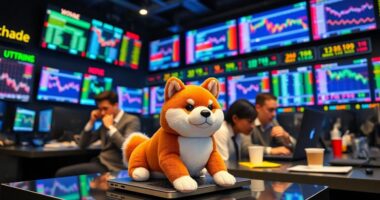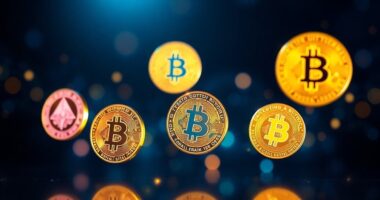Nft-based altcoins are revolutionizing how you own and trade digital art, collectibles, and virtual assets. They represent unique items securely on the blockchain, allowing you to buy, sell, and transfer digital ownership with transparency and minimal fees. Marketplaces function as digital galleries, connecting creators directly with buyers while proving authenticity. If you explore further, you’ll discover how this technology is shaping the future of digital ownership and the global economy.
Key Takeaways
- nft-based altcoins represent ownership of unique digital assets like art, music, and collectibles on the blockchain.
- These tokens provide verifiable proof of authenticity and ownership history for digital items.
- Marketplaces serve as platforms for buying, selling, and showcasing nft-based altcoins, ensuring transparency.
- Digital ownership via blockchain simplifies transfer, reduces counterfeit risks, and enables global access.
- The growth of nft-based altcoins is transforming digital asset markets and expanding digital ownership opportunities.

Have you ever wondered how digital assets are evolving beyond traditional cryptocurrencies? Today, the landscape is expanding rapidly, with nft-based altcoins playing a significant role in redefining digital ownership. Unlike standard cryptocurrencies, these altcoins are often tied to specific assets like art, music, or collectibles, allowing you to own a unique digital item rather than just a unit of currency. This shift means you’re not only trading tokens but also gaining verifiable proof of ownership on the blockchain, which is stored securely and transparently. As a result, you can buy, sell, and trade digital assets with confidence, knowing that the blockchain marketplace ensures authenticity and scarcity. This new form of digital ownership opens doors to creators, collectors, and investors who want a more direct connection to the assets they value.
In blockchain marketplaces, nft-based altcoins serve as the backbone for buying and selling these digital assets. These platforms act like digital auction houses or galleries, where you can browse an array of tokens linked to art, videos, virtual goods, or even virtual real estate. When you participate, you’re not just exchanging money for a digital item—you’re acquiring a piece of the blockchain’s history and proof of authenticity. The marketplace’s transparent nature makes it difficult for counterfeit or duplicate assets to circulate, giving you peace of mind in every transaction. These marketplaces also foster vibrant communities where creators can showcase their work directly to interested buyers, bypassing traditional gatekeepers like galleries or auction houses. This democratization of access enables you to discover rare collectibles or emerging artists from around the world, all within a secure, user-friendly environment. Additionally, ownership security is reinforced through blockchain technology, which records every transaction immutably.
Ownership of these digital assets is secured through blockchain technology, which records every transaction immutably. When you purchase an nft-based altcoin, you’re fundamentally minting a digital certificate of ownership that’s stored on the blockchain. This certificate can be transferred or sold easily, often with minimal fees, and it guarantees you’re the rightful owner. This system has transformed how we think about ownership, especially for unique items that once required physical possession. Now, with a few clicks, you can hold a one-of-a-kind digital artwork or collectible in your digital wallet, with the assurance that your ownership is verifiable and protected. As more artists, brands, and collectors embrace this technology, the boundaries of digital ownership continue to expand, making nft-based altcoins a pivotal part of the future digital economy.
Frequently Asked Questions
How Do Nft-Based Altcoins Differ From Traditional Cryptocurrencies?
NFT-based altcoins differ from traditional cryptocurrencies because they focus on digital scarcity and ownership verification. Unlike regular coins, these tokens represent unique assets like art or collectibles, making each one distinct. You can verify ownership easily and trust that the asset isn’t duplicated or stolen. This uniqueness adds value beyond simple currency use, allowing you to own, trade, or display one-of-a-kind digital items securely on the blockchain.
What Are the Environmental Impacts of Nft-Based Altcoins?
You might be concerned about the environmental impacts of NFT-based altcoins, which typically have high energy consumption due to blockchain operations. This leads to a significant carbon footprint, especially with proof-of-work systems. As a result, their environmental impact can be substantial. However, some projects are shifting to eco-friendly models like proof-of-stake, reducing energy use and helping lower their overall carbon footprint.
Can Nft-Based Altcoins Be Used for Fractional Ownership?
Yes, you can use NFT-based altcoins for fractional ownership of digital assets. This allows you to buy, sell, or trade smaller shares of valuable items like art or collectibles, making them more accessible. By dividing ownership into fractions, you gain flexibility and liquidity. This approach helps democratize access to high-value digital assets, letting you participate in investments with lower capital while still holding a stake in the overall asset.
How Secure Are Transactions Involving Nft-Based Altcoins?
Transactions involving nft-based altcoins are generally secure if you’re aware of potential smart contract vulnerabilities and guarantee proper transaction encryption. You should verify the security measures of the platform you’re using, as smart contract bugs can be exploited. Always use trusted wallets with encryption features, and keep your private keys safe. Staying informed about security updates and best practices helps protect your assets during transactions.
What Legal Issues Surround Nft-Based Altcoins and Digital Ownership?
Think of legal issues surrounding NFT-based altcoins as steering through a maze with shifting walls. You must respect intellectual property rights, ensuring you own or have permission for digital assets. Regulatory compliance is crucial to avoid legal pitfalls, as laws evolve around digital ownership and cryptocurrencies. Failing to follow these rules can lead to disputes, fines, or loss of assets. Stay informed and consult legal experts to keep your digital journey secure.
Conclusion
As you plunge into the world of NFT-based altcoins, remember that you’re holding the key to revolutionizing art and collectibles. This technology isn’t just a trend; it’s a seismic shift that could redefine value itself. Embrace the innovation with eyes wide open, because missing out would be like overlooking a once-in-a-lifetime meteor shower—an opportunity so rare it could change your entire perspective on ownership and creativity forever.









